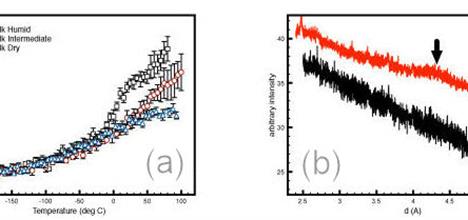The formation of silk fibres by both spiders and silk worms is characterised by a conversion of disordered proteins to sheet structures (known as β-sheets), followed by assembly into fibres. It has been hypothesised that the interplay of water and silk proteins' structural flexibility is key to this transition. To test this hypothesis, we have used quasi-elastic neutron scattering to investigate the effect of hydration on silk protein dynamics.
During the experiment we monitored simultaneously the evolution of structure β-sheet crystallinity) and polymer chain dynamics with increasing temperatures. We found that low and high dehydration levels prevent structural conversion, whereas intermediate water content promotes β-sheet conversion. The results suggest that a clever control of local fluctuation may be the key to enabling and/or inhibiting silk protein conversion and consequently their assembly into fibres.

(a) Effect of increased hydration on the bulk motion (mean square displacement) of silk proteins films. (b) Neutron diffraction spectrum taken before (black) and after (red) conformational change. The Bragg reflection at 4.3 Å is evidence of regular spacing.
C Dicko, I Diddens (Oxford University), AE Terry, MTF Telling (ISIS), F Vollrath (Oxford University)
Contact: Dr. Cedric Dicko, Cedric.dicko@zoo.ox.ac.uk
Further reading: C Dicko et al., Biomacromolecules 9 (2008) 216
